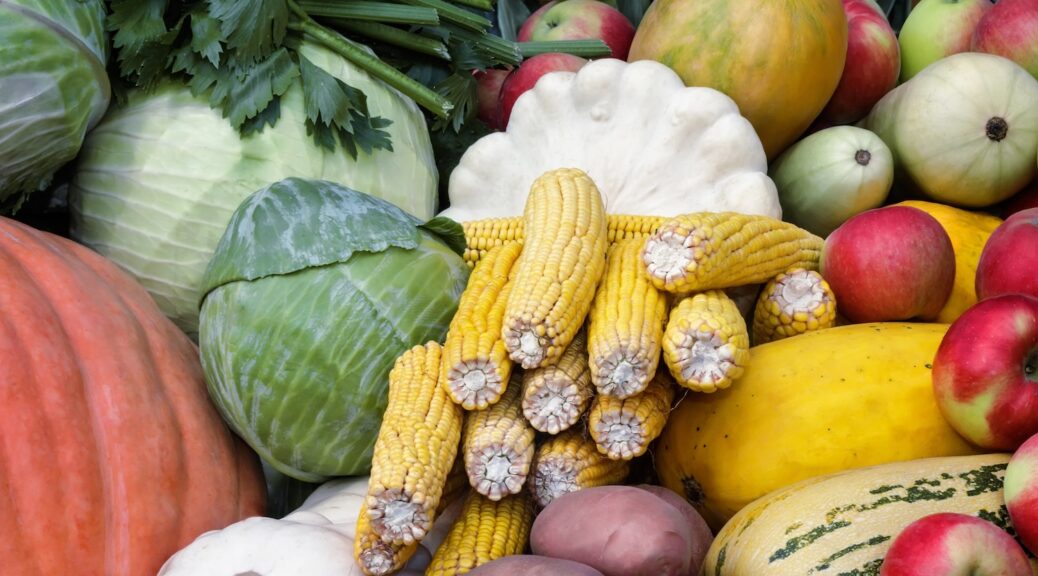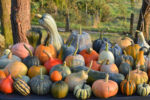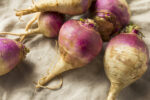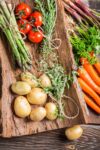
Seasonal Vegetables in the 1800s
For most of the 1800s, people in the United States lived in rural areas. But by 1890, 28% of the population was living in urban areas. Since people who lived in towns and cities weren’t able to grow many vegetables, they had to plan their meals based on what was in season.
It wasn’t until 1850 that commercially canned vegetables became available. Peas were the first vegetable canned, with beets, corn, tomatoes, and cucumbers (for pickles) available later.
INFORMATION BELOW COMPILED FROM 1800s COOKBOOKS:
POTATOES
Bermuda sends new potatoes into Northern markets about the last of March or first of April. Florida soon follows, and one Southern State after another continues the supply until June, when the Northern and Eastern districts begin. It is only the rich, however, who can afford new potatoes before July; but the old are good up to that time, if they have been well kept and are properly cooked.
SQUASHES
Squashes come from the South until about May, and we then have the summer squash till the last of August, when the winter squash is first used. This is not as delicate as the summer squash, but is generally liked better.
GREEN PEAS
Green peas are found in the market in February, though they are very expensive up to the time of the home supply, which is the middle of June, in an ordinary season, in the Eastern States. They last until the latter part of August, but begin to grow poor before that time. There is a great variety, some being quite large, others very small. The smaller are the more desirable, being much like French peas. When peas are not really in season it is more satisfactory to use French canned peas, costing forty cents a can. One can is enough for six persons. When buying peas, see that the pods are green, dry and cool. If they have turned light, they have been picked either a long time or when old.
SPINACH
Spinach is always in season, but is valued most during the winter and spring, as it is one of the few green vegetables that we get then, and is not expensive. It should be green and crisp.
ASPARAGUS
Asparagus, from hot houses IN the South, begins to come into the market in March and April. It is then costly, but in May and June is abundant and quite cheap. About the last of June it grows poor, and no matter how low the price, it will be an expensive article to buy as it has then become very “woody.” The heads should be full and green; if light and not full, the asparagus will not spend well.
CAULIFLOWER
This vegetable is generally quite expensive. It is found in the market a greater part of the year, being now grown in hot houses in winter. It is in perfection from the first of May to November or December. The leaves should be green and fresh and the heads a creamy white. When the leaves are wilted, or when there are dark spots on the head, the cauliflower is not good.
TOMATOES
The fresh tomato comes to the market from the South in April and sometimes in March. On account of the high price, it is then used only where the canned tomato will not answer. In July, August and September it is cheap. It comes next to the potato in the variety of forms in which it may be served. By most physicians it is considered a very healthful vegetable. The time to buy ripe tomatoes for canning is about the last of August, when they are abundant and cheap. About the middle or last of September green ones should be secured for pickling, etc. As the vines still bear a great many that cannot ripen before the frost comes, these are sold for this purpose.
CELERY
Celery is found in the market from August to April, but is in its prime and is cheapest from November to the first of March. Before the frost comes it is slightly bitter, and after the first of March it grows tough and stringy. Unless one has a good cellar in which to bury celery, it is best to purchase as one has need from time to time. Celery is a delicious salad. It is also considered one of the best vegetables that a nervous, rheumatic or neuralgic person can take. The heads should be close and white, and the stalks should break off crisply. Save the trimmings for soups.
LETTUCE
Lettuce is found in the market all the year round, being now raised in hot houses in winter. It then costs two and three times as much as in summer; still, it is not an expensive salad. There are a number of varieties having much the same general appearance. That which comes in round heads, with leaves like a shell, is the most popular in this country, because it can be served so handsome. There is another kind, high in favor in Paris and in some localities in this country for its tenderness and delicate flavor, but not liked by marketmen, because it will not bear rough handling. The time will come, however, when there will be such a demand for this species that all first-class provision dealers will keep it. The French call it Romaine, and in this country it is sometimes called Roman lettuce. It does not head. The leaves are long and not handsome whole; but one who uses the lettuce never wishes for any other. Lettuce should be crisp and green, and be kept until used in a very cold place–in an ice chest if possible.
GREEN CORN
Green corn* is sent from the South about the last of May or the first of June, and then costs much. It comes from the Middle States about the middle of July and from the Eastern in August, and it lasts into October in the North Eastern States. It should be tender and milky, and have well-filled ears. If too old it will be hard, and the grains straw colored, and no amount of boiling wilt make it tender. Corn is boiled simply in clear water, is made into chowders, fritters, puddings, succotash, etc.
*Green corn – refers to the husks of the corn being green. Sweet, fresh corn, not field corn fed to animals, or popcorn.
CUCUMBERS
Cucumbers are in the market all the year round. In winter they are raised in green houses and command a high price. They begin to come from the South about the first of April, and by the last of May the price is reasonable. They last through the summer, but are not very nice after August They are mostly used as a salad and for pickles, but are often cooked. They should be perfectly green and firm for a salad, and when to be pickled, they must be small. If for cooking, it does no harm to have them a little large and slightly turned yellow.
RADISHES
There are two forms of the radish commonly found in the market, the long radish and the small round one. They are in the market in all seasons, and in early spring and summer the price is low. Radishes are used mostly as a relish.
CABBAGE is in season all the year.
BEETS, CARROTS, TURNIPS and ONIONS are received from the South in April and May, so that we have them young and fresh for at least five months. After this period they are not particularly tender, and require much cooking.
=================================================
Do You Use Fresh, Frozen, or Canned Vegetables? Please Leave a Comment Below.
=================================================




